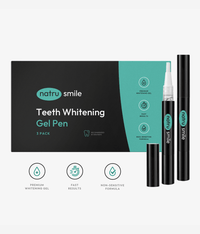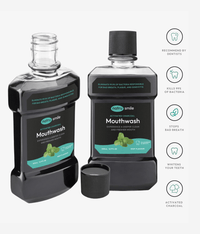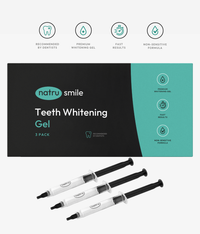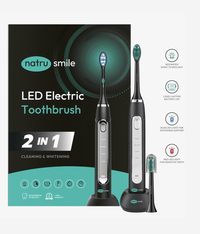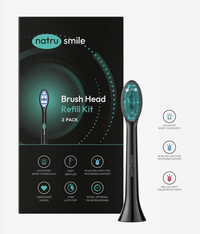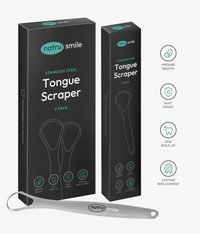
All products are certified by dental expert Dr. Greg Grillo
It goes without saying that regular dental care (i.e., brushing your teeth twice daily) is essential for maintaining healthy teeth. But for those with significant discoloration, routine oral hygiene won't be enough to make teeth gleam.
Of course, in-office teeth whitening is the best choice for fast results and long-lasting whiteness. But these procedures can cost hundreds or thousands of dollars (plus maintenance).
So how can people achieve a brighter smile without dropping major cash? In this article, we'll show you the best teeth whitening options for natural whitening in 2023.
Natural Teeth Whitening: An Overview
Whether you're looking to whiten your teeth naturally or with a professional whitening system, it's important to understand the basics of how teeth whitening works.
When our teeth become stained, they take on a yellowish hue because of the dentin beneath the surface of the enamel. Teeth whitening products and treatments use bleaching agents (like hydrogen peroxide) or abrasives (like baking soda) to break down the molecules of these stains and dissolve them away.
Teeth whitening solutions you can find over the counter or through professional treatments contain more powerful bleaching agents than those found in natural products (as well as other chemicals and additives). But the results are worth it when you're looking for a fast fix.
There are several benefits to natural teeth whitening:
- Everyday materials and applications make for a much lower teeth whitening cost.
- No chemicals and additives means less risk for sensitivity.
- Home remedies are safe and gentle on teeth, resulting in a much lower risk of damaging the enamel or causing gum irritation.
Believe it or not, two of the main ingredients in store-bought and dentist-administered whitening products—hydrogen peroxide and baking soda—are also proven home remedies for natural teeth whitening.
If your teeth have only mild discoloration, or if you want a whiter smile without the cost or the chemicals, then natural teeth whitening is for you.
5 Natural Ways To Whiten Your Teeth
Whether you have sensitive teeth, a limited budget, or just want to try something new, you can enjoy the benefits of white teeth without harsh bleaching agents or costly treatments. Here are five natural ways to whiten your teeth at home.
1. Hydrogen Peroxide
If you've ever fallen and scraped yourself, chances are you've used hydrogen peroxide to clean the wound. It's an excellent antiseptic thanks to its powerful oxidizing properties.
Hydrogen peroxide is also the main ingredient in many at-home teeth whitening products you see at the store. From whitening strips to light-activated gels, hydrogen peroxide is the go-to bleaching agent for fighting tooth stains.
Research proves that hydrogen peroxide is effective in teeth whitening. But professional bleaching agents contain high levels of hydrogen peroxide.
Commercial products can contain as much as 10% hydrogen peroxide, while the whole bottle you'd find in your local pharmacy is typically only 3%. And dental treatments can have a peroxide content of 35% or more.
High-concentration peroxide products pose some safety risks for patients:
- Greater concentrations of peroxide can erode enamel, causing sensitivity and eventual decay.
- Gum irritation or burning can occur, especially in patients who have gum disease or other serious oral health issues.
- Overuse or over-application of peroxide can damage the enamel, leading to costly repairs.
- Patients with severe sensitivity find that peroxide-based products are too harsh for their teeth.
Store bought hydrogen peroxide is in much smaller concentrations and can be diluted even further, making it an excellent option for sensitive teeth. It's also inexpensive, so it's less cost-prohibitive than other teeth whitening options.
Here's how to use hydrogen peroxide for teeth whitening:
- Mix equal parts 3% hydrogen peroxide with water.
- Swish the solution in your mouth for one minute, then spit it out.
- Make sure not to swallow the mixture.
- Rinse your mouth with water afterward.
- Repeat this process once daily for about a week or two.
When using hydrogen peroxide at home, many of the same safety concerns still apply. Preexisting oral conditions and sensitive teeth can make bleaching with hydrogen peroxide difficult, and overuse can lead to enamel erosion and other serious oral health issues.
When whitening without dental supervision, you can never know exactly how your teeth will react to a bleaching agent. So proceed with caution, and always start by using less than recommended concentrations of peroxide.
2. Baking Soda
Baking soda is a natural cleaner. You've probably seen it in laundry detergent, cleaning products, and—you guessed it—the toothpaste aisle at your local grocery store.
Despite its low abrasiveness, baking soda is more effective at whitening teeth than almost any other whitening solution.
According to extensive research, there are several benefits to whitening at home with baking soda:
- Baking soda has a low level of abrasiveness, making them ideal for daily use as part of an effective oral hygiene routine.
- Microbiological research has discovered that baking soda products boast a potent bactericidal capability towards oral pathogens, eliminating plaque and reducing the risk of gingivitis and other conditions.
- By neutralizing plaque acids, baking soda helps to break down certain particles that adhere to teeth, leading to a brighter smile with fewer cavities.
- Because it doesn't contribute to root sensitivity, baking soda can be used safely and effectively even on sensitive teeth.
Although it isn't a substitute for anticavity fluoride toothpaste, baking soda can be used to supplement traditional products in your daily brushing routine.
To whiten your teeth with baking soda, the process is as follows:
- Combine one teaspoon of baking soda with a small amount of water.
- Mix the solution until it forms a paste.
- Gently brush your teeth and gums with the paste for one to two minutes.
- Thoroughly rinse your mouth with water.
Many people also add baking soda to their regular toothpaste, which is an easy way to work it into your daily oral care routine. In fact, this is the best way to use baking soda to whiten teeth, as it combines the anticavity and whitening benefits of regular toothpaste with the strength of baking soda.
Plus, adding baking soda to your toothpaste won't increase abrasiveness the way that whitening toothpaste will.
3. Oil Pulling
Oil pulling is an ancient Ayurvedic (i.e., traditional Indian) treatment method that involves swishing oil around in the mouth for up to 20 minutes. This technique is designed to draw out toxins and bacteria from the gums, teeth, and tongue, leading to fresher breath, healthier teeth and gums, reduced tooth decay and inflammation, and brighter teeth.
Oil pulling usually involves swishing a tablespoon of coconut oil, sesame seed oil, or sunflower oil around your mouth every morning on an empty stomach before brushing your teeth.
After 15-20 minutes of swishing, spit out the remaining liquid in a trash bin (not your sink!) and rinse your mouth with warm water.
According to a PubMed study, there are several benefits to oil pulling:
- Reduced plaque
- Fight against gingivitis
- Better breath
- Reduced risk of other non-oral diseases
- Less need for restorative dental treatments
Many users say it whitens their teeth as well, although scientific research does not yet support this claim.
Still, oil pulling is a safe and natural way to improve your smile. And since it's an easy and painless practice, it's worth a try if you're looking for ways to naturally whiten your teeth.
4. Consume The Right Foods And Drinks
Some foods and drinks can damage your teeth, including coffee, sugary snacks, and red wine. All of these are known for staining teeth, eroding tooth enamel, and causing other damage.
But there are also foods and beverages you can eat to improve your teeth:
- Dairy Products: Dairy products are rich in calcium, which is essential for strong teeth and bones. Beyond that, the lactic acid in dairy products helps to break down plaque and keep teeth clean. One study showed that casein (a stain-resistant protein found in milk) could prevent the formation of dental caries and inhibit the discoloration of teeth caused by the tannins in certain beverages such as coffee and tea.
- Strawberries: Strawberries are a natural teeth whitener. The malic acid in strawberries helps to remove surface-level stains from your teeth, while vitamin C works to break down plaque buildup.
- Watermelon: Watermelon is higher in malic acid than other fruits, making it a great choice for teeth whitening. The natural sugar in watermelon also helps remove surface stains and brighten your smile.
- Pineapple: Pineapple is a natural source of bromelain, an enzyme that helps to break down plaque and discoloration. Eating pineapple regularly can help whiten your teeth over time.
- Papaya: Papaya is a rich source of vitamin A and papain, an enzyme that helps remove surface staining from your teeth. It is also similar to pineapple in its content of bromelain, which helps to break down plaque.
None of these foods are substitutes for brushing and flossing, but being food-conscious can help keep your teeth looking brighter and whiter.
5. Flossing
Flossing does not actually whiten your teeth—it helps remove plaque and debris from between your teeth. But since plaque buildup can cause discoloration, flossing can help keep stains from forming and brighten your overall smile.
Flossing should be part of your daily oral hygiene routine. It is best to floss at least once a day (ideally before brushing). Use a gentle and slow sawing motion to remove plaque from each tooth, then rinse your mouth thoroughly with water.
For best results, use an interdental brush or proxy brush (a tiny bristled brush that fits between teeth) every day. This will help remove food particles and debris, which can prevent discoloration and promote strong, healthy teeth and gums.
Natural Whitening Methods That Don't Work
Not all teeth whiteners are created equal—there are plenty of fads out there that don't work. Some of the most popular home whitening solutions that miss the mark include:
1. Lemons
Some influencers and home remedy sites swear by using lemon juice to whiten teeth. However, the acidic nature of lemons can actually erode tooth enamel and cause significant damage over time.
When it comes to your teeth, applying an acid as strong as lemon juice for a prolonged period is just as bad as drinking soda or other sugary drinks.
2. Oranges
The same way that lemons can cause damage, so can oranges. The acidic nature of the fruit makes it a bad choice for whitening teeth and can lead to enamel erosion.
Many websites and non-scientific sources also claim that orange peels can be used to whiten teeth because of their vitamin C content. But the peels also contain acid, making them just as damaging to your teeth.
3. Apple Cider Vinegar
Apple cider vinegar has a wide range of health benefits, including being good for digestion and helping with skin health. But teeth whitening is not one of them.
Some of the active ingredients in apple cider vinegar are good for your dental health, including malic acid. But vinegar is highly acidic, and overuse can cause damage to tooth enamel.
4. Activated Charcoal
People began to think activated charcoal whitens teeth because of its absorbent properties. But in reality, activated charcoal actually absorbs the natural minerals from your teeth, leading to discoloration. It is also highly abrasive, meaning it can cause teeth whitening side effects without actually whitening your teeth.
According to WebMD, activated charcoal changes the surface of teeth. And despite its abrasion, it does not affect their whiteness.
Want to know more? Here are a few questions our customers frequently ask us:
How Long Does It Take For Yellow Teeth To Turn White Naturally?
The teeth whitening duration varies depending on the severity or discoloration.
Although there is no clear answer, it typically takes between 1–3 weeks to see noticeable results. If you have significantly stained teeth, it may take longer to fully whiten teeth, but you may also see more noticeable results right away.
Will Natural Teeth Whitening Methods Ruin My Enamel?
Choosing the right methods of natural teeth whitening can help protect your enamel. Be sure to avoid acidic ingredients like lemon and orange juice, as well as activated charcoal and apple cider vinegar. To limit side effects, baking soda is the best natural option, as it is highly effective and gentle on your teeth.
Is Natural Teeth Whitening Safe?
Teeth whitening safety is relative. The ADA recognizes teeth whitening practices as safe, but overuse can lead to side effects like tooth sensitivity and enamel erosion. If you have sensitive teeth or preexisting dental conditions, these symptoms can be even more pronounced. To stay safe, avoid using natural teeth whitening methods in excess or for prolonged periods of time.
Final Thoughts
If you want to avoid the expensive costs and harsh chemicals of professional teeth whitening, you can look to natural methods instead. Baking soda is the best and safest way to naturally whiten your teeth in 2023, but hydrogen peroxide is another solid option.
If you want the most natural solutions, making dietary changes and oil pulling may help you reach your whitening goals. But bear in mind that these methods are mostly ways to prevent further staining or discoloration and improve your overall oral health.
Overall, natural teeth whitening is possible if you choose the right methods and ingredients that won’t harm your teeth. When in doubt, it’s always best to speak with a dental professional first.


